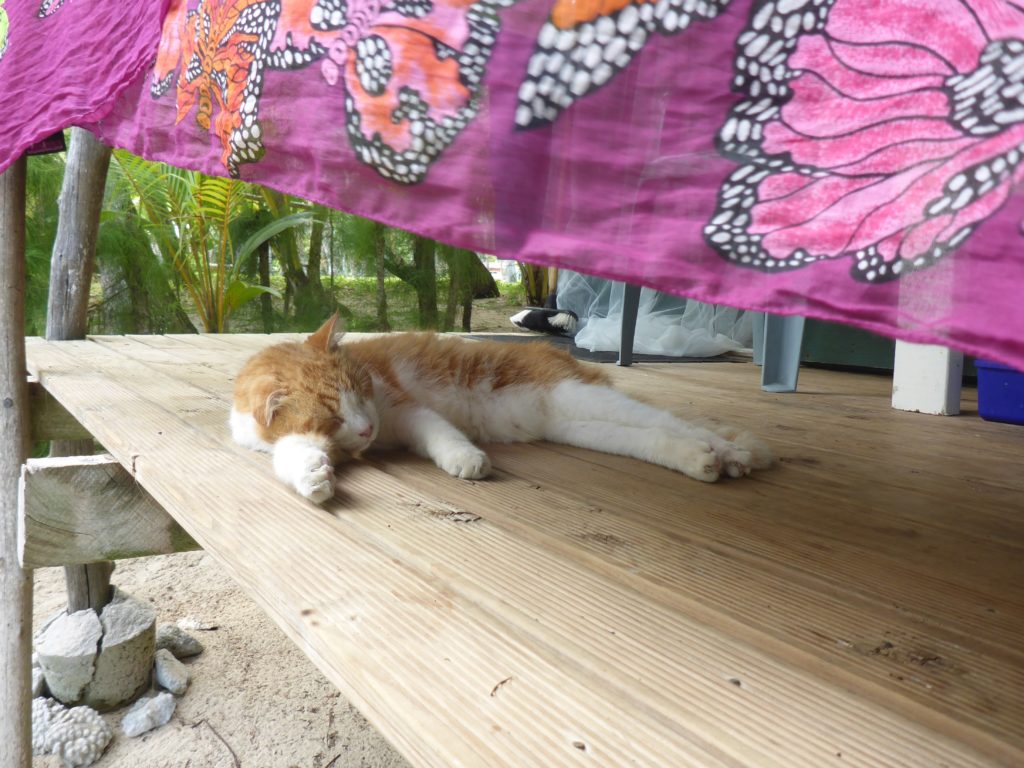
Matriki’s motto, ‘Just casual’, applies to everyone who stays here… Even Matriki’s cats! Marmalade (pictured above) especially liked a regular snooze on the porch of my beach hut, giving an excellent example of how to kick back and chill out tropical-style.
Eleven days into my South Pacific travels and with three weeks to go, time felt like it was passing far too quickly. I was beginning to settle into Aitutaki’s laid-back atmosphere: wandering along the beach or swimming in the turquoise sea to cool off in the midday heat; enjoying the marine life of the coral reef; talking with other tourists and local folks about Aitutaki culture, wildlife and history.
I was learning a lot about the ways in which Cook Islanders use natural resources, such as plants. At dusk if I walked along the beach, the sand along the treeline was scattered with the fallen blooms of beach hibiscus (Hibiscus tiliaceus), called ‘Au or String Tree in local parlance. Strips of this tree’s inner bark are soaked in the lagoon for three weeks before being dried for twenty-four hours in the sun: these prepared fibre strips (called kiri’au) are then bleached or dyed and made into the so-called ‘grass skirts’ and leggings used as dance costumes for performances on Island Nights.
The sustainable use of local resources is important on an island where even things such as soil and fresh water are in limited supply and many consumables are imported. Talking over lunch at Tauono’s (a local organic gardening project with a cafe) with a Kiwi traveller called Tim, I learned that the huge container ship that visits Aitutaki regularly to bring in supplies cannot enter the harbour at Arutanga – the ship being simply too big to pass through the channel in the reef. Instead a cargo barge chugs out to the ship and brings in containers of goods, at a cost of $3,500 per trip! Small wonder then that even simple groceries like bread, cheese and tinned goods are expensive to buy on Aitutaki.
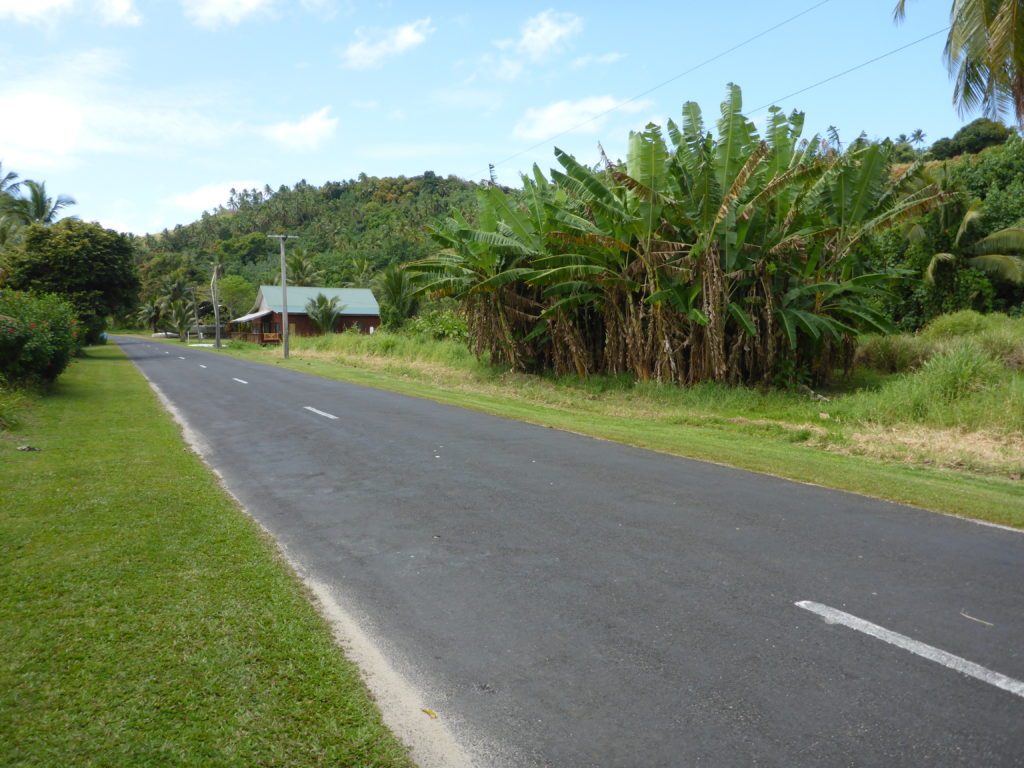
Expensive or not, I needed some basic supplies: so I set out on the two-mile walk along Aitutaki’s main road from Matriki to the downtown metropolis of Arutanga. I’d only been walking ten minutes when with typical Cook Islands generosity a friendly local offered me a ride there in his pick-up. I pottered about in Arutanga shopping for essentials (bread, cheese, fresh veg, beer) before strolling back home to Matriki. As there was virtually no traffic and I’m insatiably nosy curious about my surroundings, I enjoyed my walk, taking in the sights… Including a big mama pig and her brood of tiny wee piglets snuffling about at the side of the road.
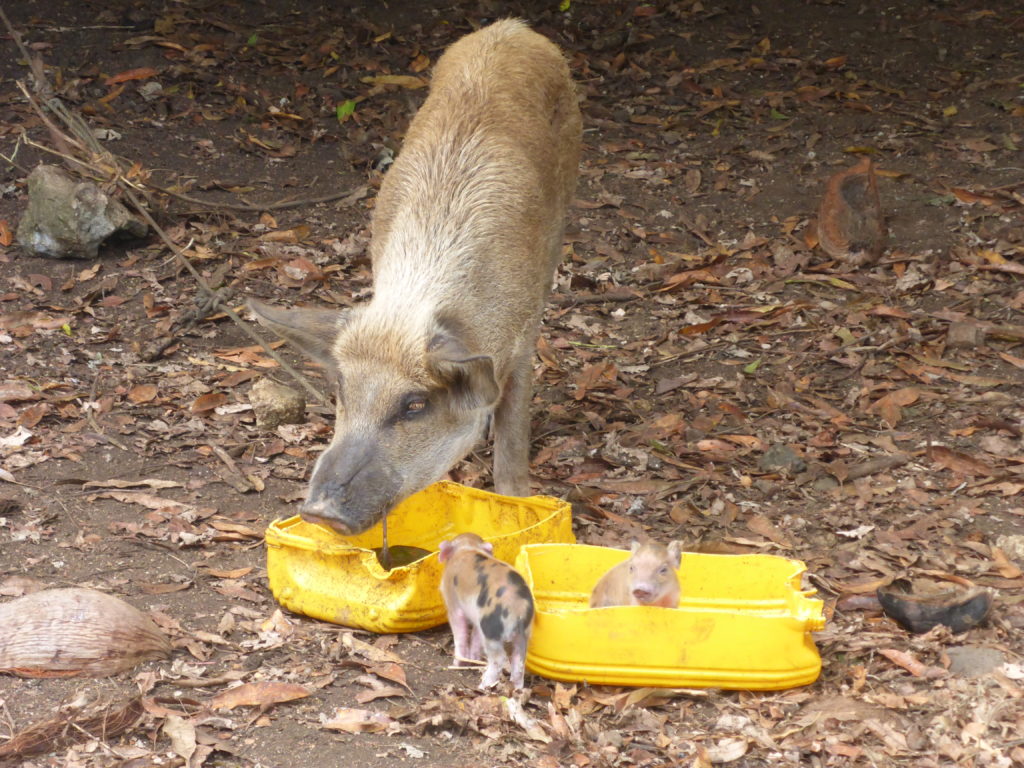
Pigs are an important domestic animal in the Cook Islands: along with chickens you see them almost everywhere, usually roaming semi-free range. Typically they’re big and furry and more like wild boar than the blobby farm-pigs we’re more familiar with in the UK. Think Were-pig and you’re in the right area. I felt inclined to treat them with respect and give them plenty of space, especially big mamas like this one. (Her spotty little piglets were über cute, though!)
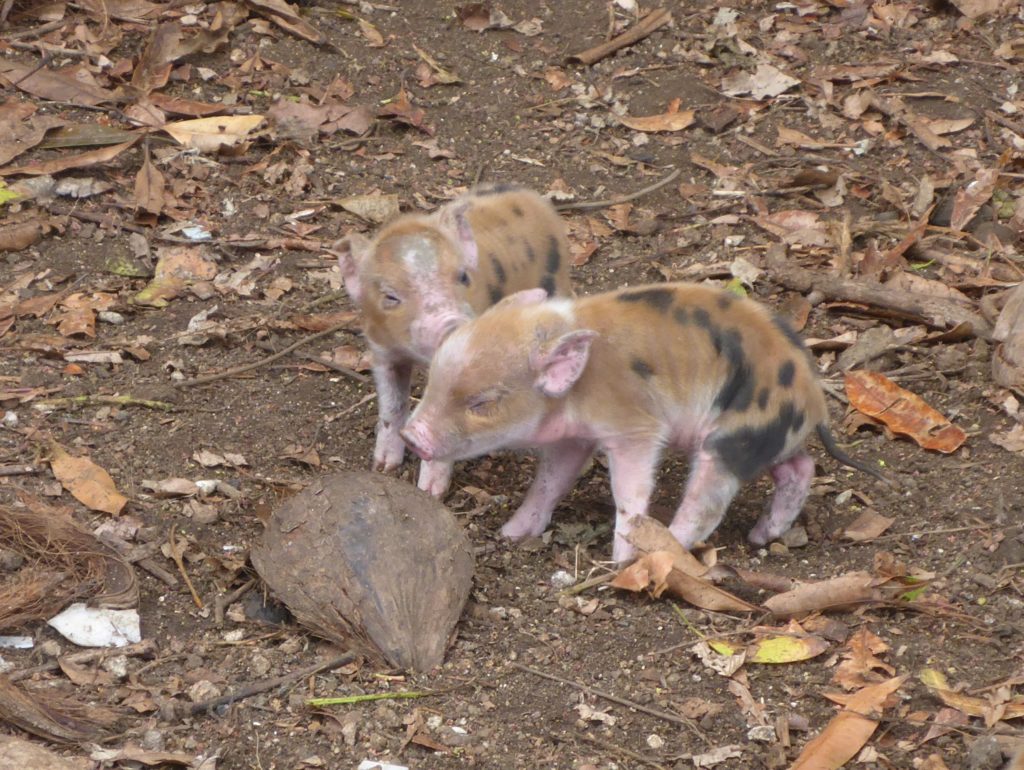
While I was in an exploring mood, I decided to go for a walk northwards and inland, to climb up Aitutaki’s highest point: the hill called Maunga Pu . At 124 metres high it wasn’t exactly Alpine, but I felt like stretching my legs and getting a bit of an overview of the landscape. Maungu Pu means “top of the mountain”: Cook Islands legend tells of how the hill was actually the summit of a high mountain called Maru on Rarotonga, which Aitutaki warriors stole and brought back to their own island!
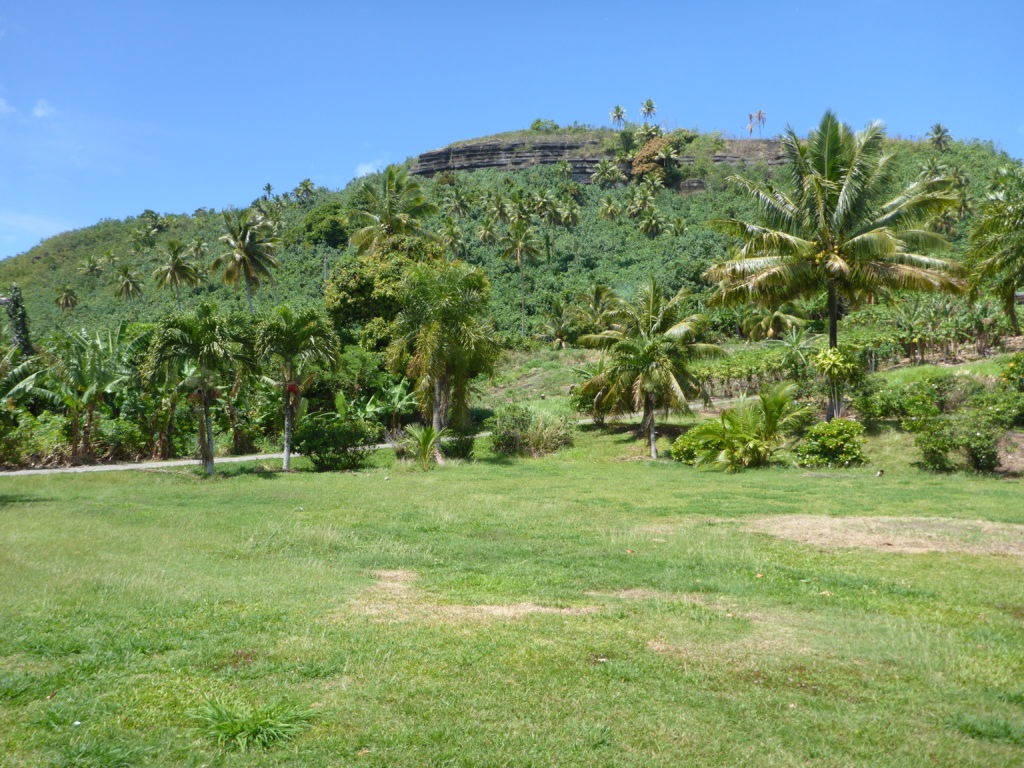
The route to the top of Maunga Pu was easy to find and follow, starting out as a decent road that led through groves of pawpaw trees (Asimina triloba, or vīnītā). I’d already eaten plenty of pawpaw fruits since arriving in the Cook Islands: they’re creamy and sweetly-scented when ripe (similar to a mango), and work well in salads and desserts… But eating too many can have a laxative effect!
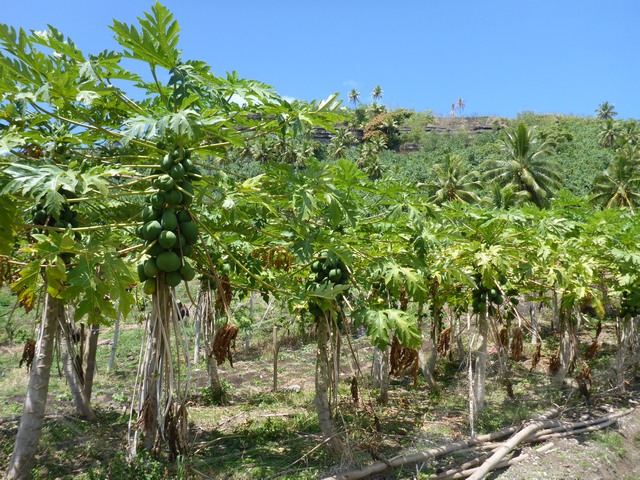
As I walked higher up the track became rougher and the views greener. As soon as you get into Aitutaki’s interior you realise how undeveloped it is. The coastal fringes are dotted with resorts and tourist accommodation, but inland is pretty much left to the locals. There’s some farming and a few access roads; two or three water tanks and some hamlets and scattered houses; and the island’s other high viewpoint, Piraki lookout.
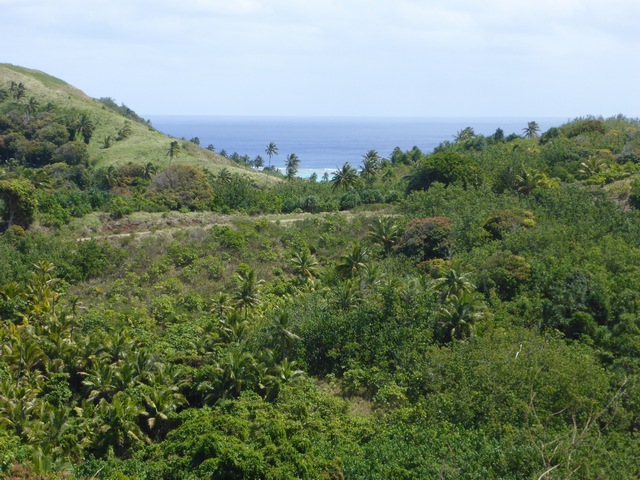
Trevor and Tracey (Matriki’s resident caretakers and hosts) had told me that there had been a bush fire up on Maunga Pu not so long ago, so I wasn’t surprised to see signs of burned palm trees and blackened ground as I climbed higher up the path. Vegetation dried by fierce tropical sun mean that a fire can get hold quickly, and strong winds on this exposed island can sweep flames over a large area.
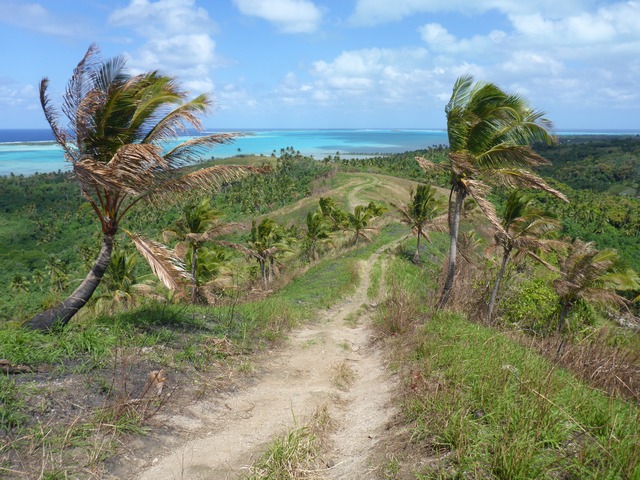
Luckily a lot of local plant species are evolved to survive in tough conditions, so most things appeared to be growing back.
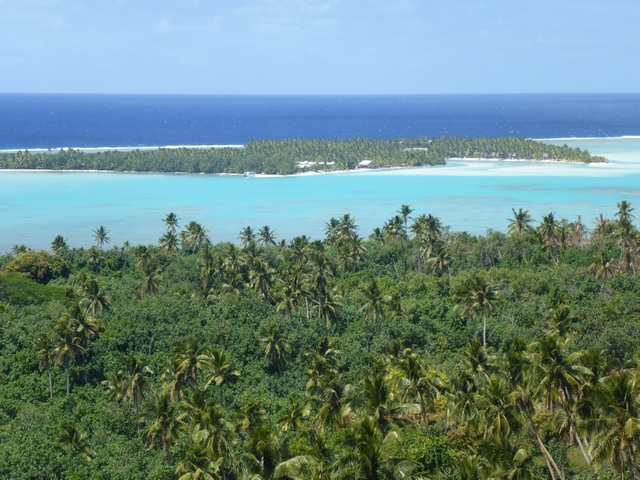
Reaching the (slightly singed) heights meant that I was able to get stunning views over the whole of Aitutaki. Looking eastwards towards O’otu, the contrast between the shallow turquoise waters of the island’s coral lagoon and the Prussian blue of the deep Pacific Ocean beyond was striking
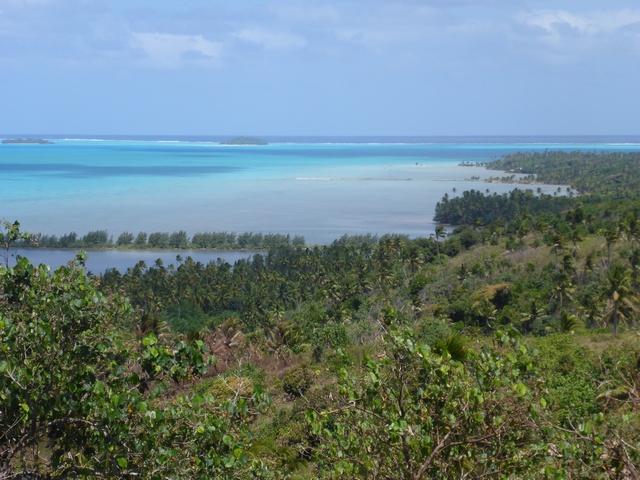
Looking south I could see Vaipae wharf on the island’s east coast, and in the distance the motu of Aitutaki’s lagoon where I’d travelled by boat with Puna only a couple of days earlier. Standing atop Maunga Pu you really get a sense of how small Aitutaki is… and how breathtakingly beautiful. These small islands in the South Pacific are absolute gems, and it’s small wonder that tourists come here for a taste of paradise.
Being tiny and relatively low-lying, however – and with the majority of their population living on or near the shoreline – the Cook Islands are incredibly vulnerable to climate change. The coral reefs are being bleached by increased UV radiation and all marine life is adversely affected by water pollution and ocean acidification. Tropical cyclones are becoming more violent, which when coupled with rising sea levels could produce potentially catastrophic flooding and loss of life.
Small wonder then that local communities are getting organised to take action and campaign for policy changes to halt climate change. Grassroots networks like 350 Pacific are working with communities across 15 Pacific Island nations to highlight the vulnerabilities of these countries, while using their strength and resilience – along with local networks and partner organisations – to challenge politicians and corporate interests. Kia manuia!
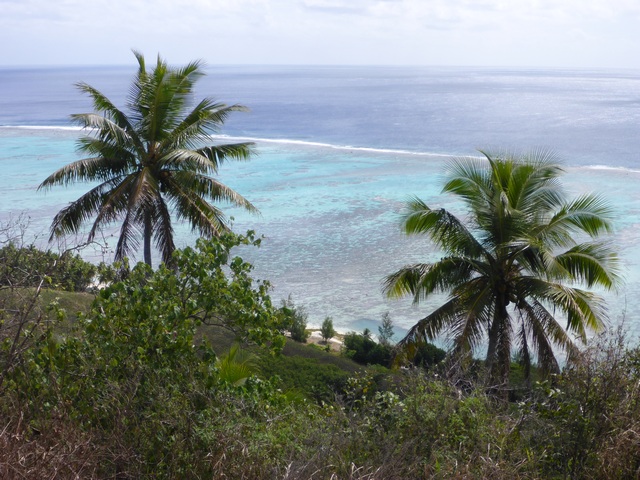
Looking westwards I could see out over the coral lagoon, narrower on this side of Aitutaki. When swimming offshore at Matriki and Vaikoa I was very focused on the marine life in the shallow waters, and didn’t tend to venture near the reef’s seaward edge. There can be tricky currents there and locals warn tourists against getting too close: but looking down on Amuri’s coast I got a tantalising view of the wide blue South Pacific beyond the reef.

On Maunga Pu’s summit there is a nice folksy piece of local history, in the form of an inscribed concrete marker celebrating a Boys’ Brigade Battalion camp up there in the early 1970s. I suspect that camping up on top of the hill must have been on the breezy side.
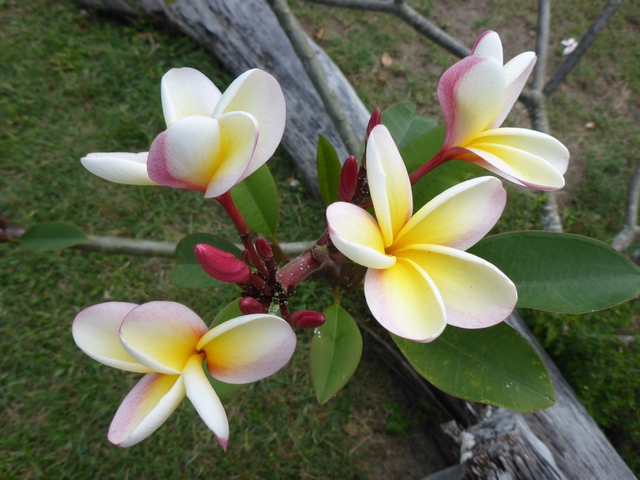
After sitting for a while on the summit to enjoy the gorgeous views and fresh breeze, I descended along the track and headed homewards to Matriki. Along the way a few plants caught my eye, including the Tahitian Gardenia (Gardenia taitensis, or tiare Māori). This ubiquitous and lovely flower is synonymous with the South Pacific, being used as a garden shrub and for scenting soap and coconut oil… yet it’s non-native to the Cook Islands. Ironically, it’s not native to Tahiti either – the plant was introduced there too, from its native range of Vanuatu, Tonga and Samoa.
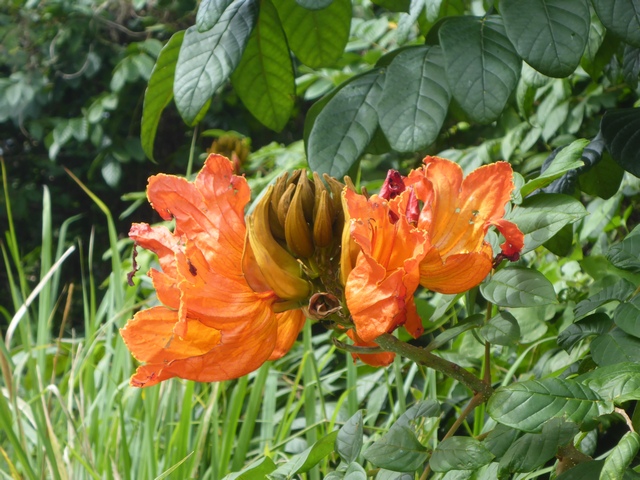
I also spotted another showy non-native that I saw in several places on my travels: the bright orange flowers of the African Tulip Tree (Spathodea campanulata). The local name for it is kō‘ī‘ī, which means “to squirt” – apparently the buds can be used to squirt water!
The tropical climate of Aitutaki means that plants flourish, which can be problematic if the plants in question are non-native invasive species like the tulip tree. Tackling these troublesome invaders is another environmental headache for local communities, with little funding available for remedial measures such as biological control.
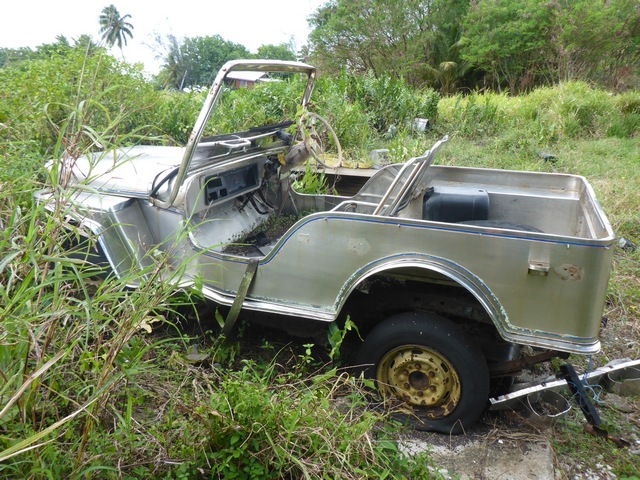
On the plus side though, nature can swiftly cover up what man has discarded: I found a rotting jeep that was being slowly carpeted with moss and ferns. Give it a few years, and it’ll probably be rusting down and buried under a flourishing green tide.
After a day of exploring on foot, the siren call of the warm tropical sea drew me back to my ideal beach bum life: snorkelling, sunbathing and strolling. The southwesterly winds which had blown in at the end of my lagoon tour with Puna a few days ago had raised a swell, stirring up the lagoon’s sandy bottom and making poor visibility for taking photographs. But the following day after my walk up Maunga Pu the weather had calmed, so I donned mask and snorkel and rash vest (to protect my healing sunburned back) and went to hang out with my fishy friends.
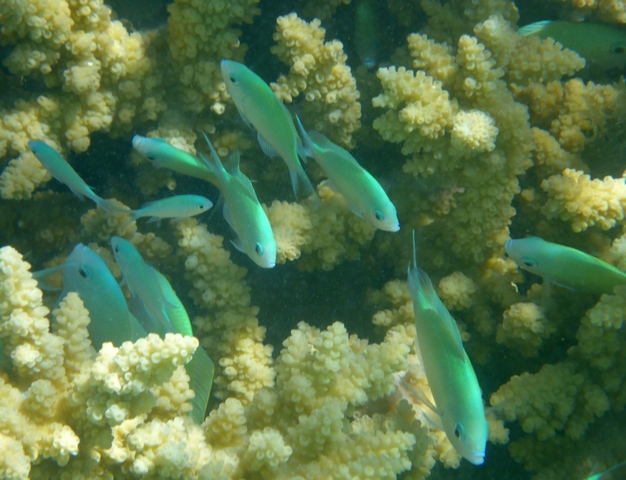
As soon as I waded into the shallows I was surrounded by teeming schools of tiddlers darting between the coral and around my legs, like green pullers Chromis viridis (local name katoti), pictured above.
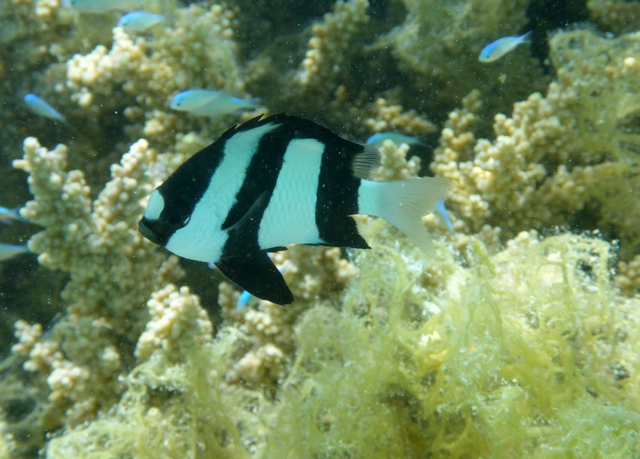
In amongst the green pullers were their katoti cousins humbug damselfish (Dascyllus aruanus), stroppy little black-and-white striped fish who often came close enough to nibble investigatively at my skin.
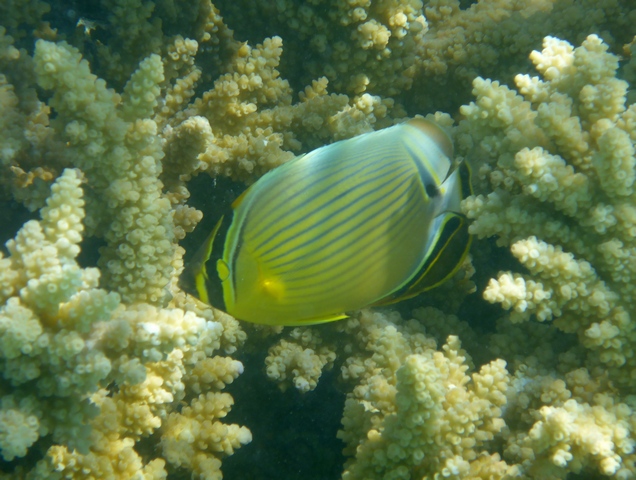
I saw an incredible variety of colourful butterflyfish (called taputapu by locals) on my snorkeling explorations around the reef. There were many different species, such as this redfin butterflyfish (Chaetodon lunulatus), pictured above…
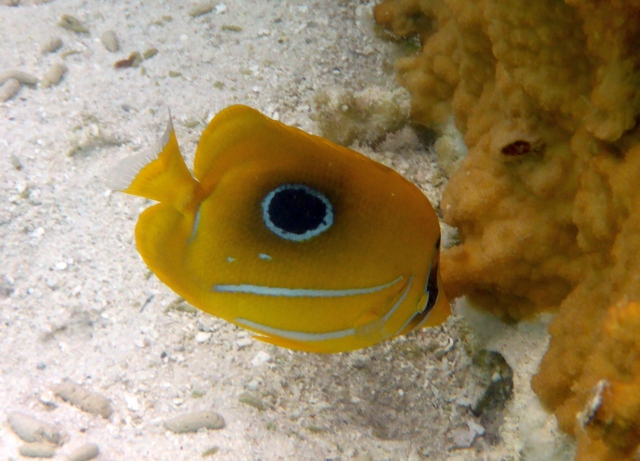
…Bennett’s butterflyfish, Chaetodon bennetti…
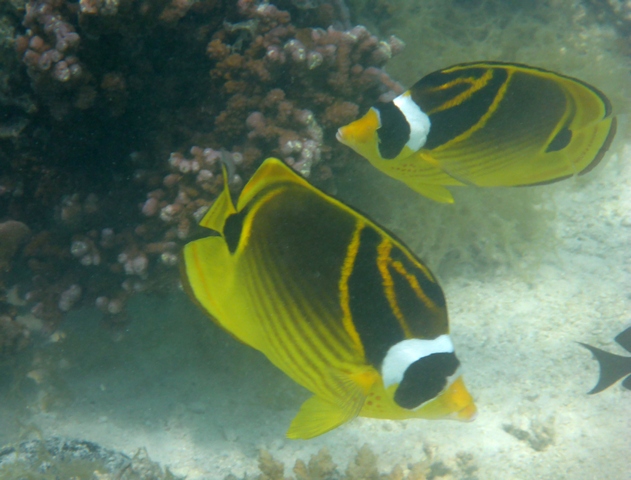
…Racoon butterflyfish, Chaetodon lunula…
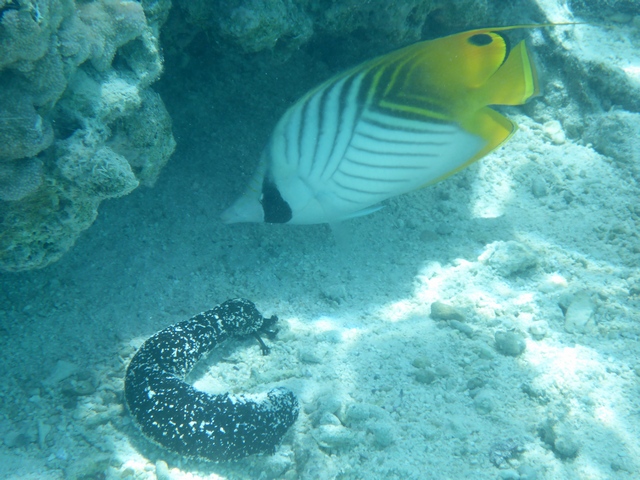
…And threadfin butterflyfish (Chaetodon auriga). The somewhat homely creature lying on the sandy bottom in this photo is a sea cucumber (Holothuroidea).
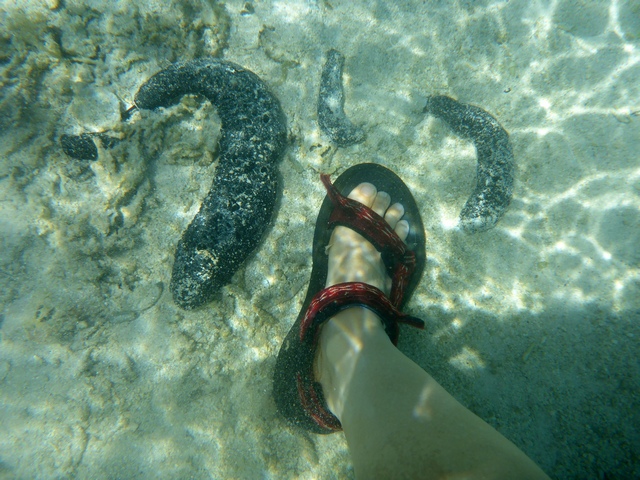
Known locally as rori – and as bêche-de-mer in French Polynesia – these cousins of the sea urchin can be found lying all over the sea bottom. Some tourists gripe about their presence, but without the sea cucumbers Aitutaki’s sands would not be as clean as they are: the rori feed by slowly ingesting the sediments of the sea bottom, sifting through it for organic matter. They are basically biological hoovers – and are also exported as food to Asian markets.
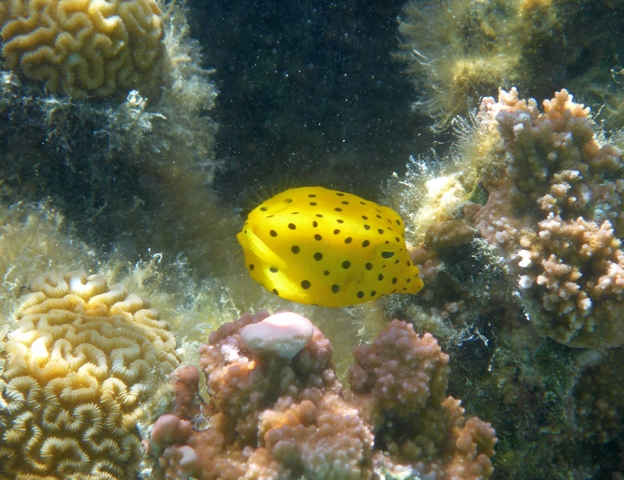
Snorkelling around coral bommies in the shallow water was like being on an underwater treasure hunt. Every new nook yielded some different marine creature to be amazed by, like this cute little yellow boxfish (Ostracion cubicus, or moamoa po’aki).
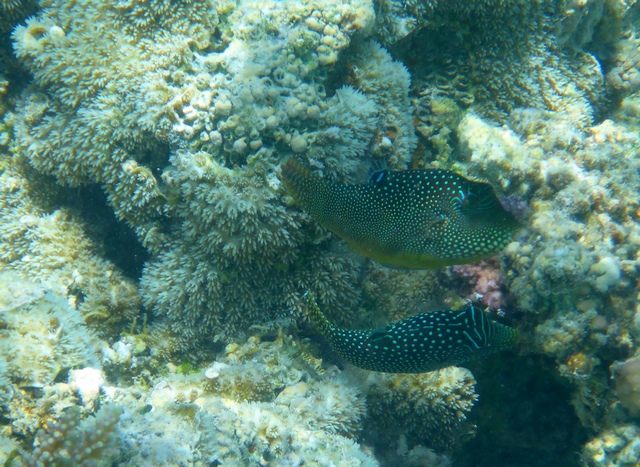
As the little boxfish disappeared the next stylish reef inhabitants that swam into view were a pair of smartly polka-dotted honeycomb toby or spotted pufferfish (Canthigaster janthinoptera, or ‘ue ‘ue).
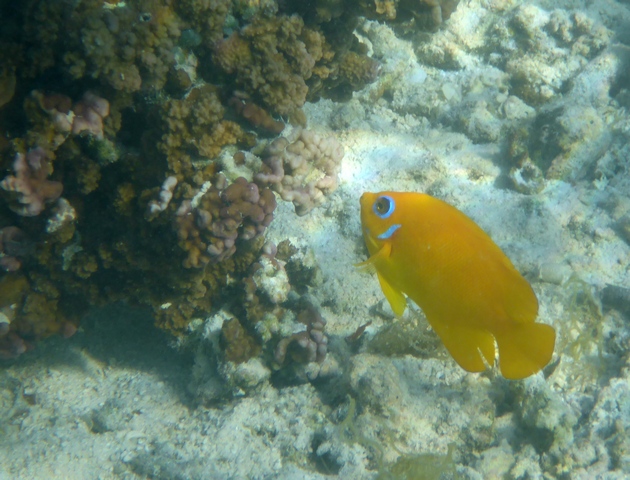
What’s amazing about this undersea world is that so many species forsake camouflage as a survival strategy and blazon forth in every hue of the rainbow. This lemon peel angelfish (Centropyge flavissima or katoti) sported such lurid blue eye-shadow that I named it ‘Barbara Cartland fish’.
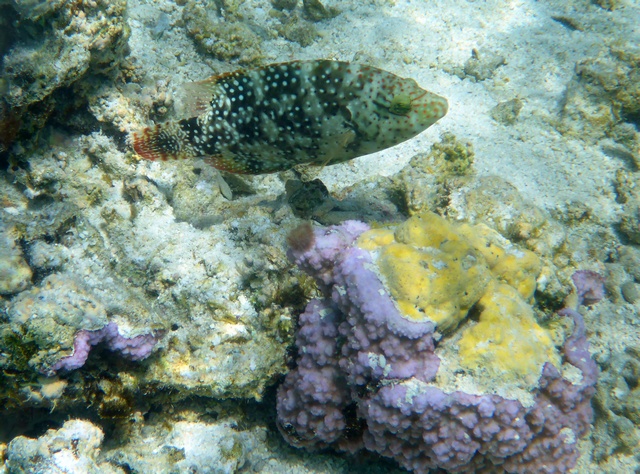
Swimming around another block of coral, I found a floral Maori wrasse (Cheilinus clorourus or kōpiropiro), displaying the amazing cryptic colouration that helps it to blend into the mosaic of bright coral and shadowy crevasses of its undersea environment.
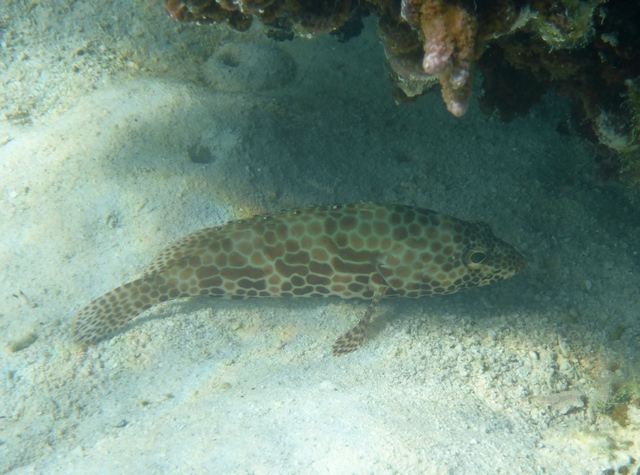
An even more striking camouflage outfit is sported by the honeycomb grouper (Epinephulus merra or taraoa), which I spotted lurking on the sea floor under the edge of a large coral bommie. The pattern of hexagonal spots on this handsome fish make it look like a creature designed by CGI. I love finding mathematical patterns in nature, for me it’s a constant reminder that science and ecology and art are all interlinked.
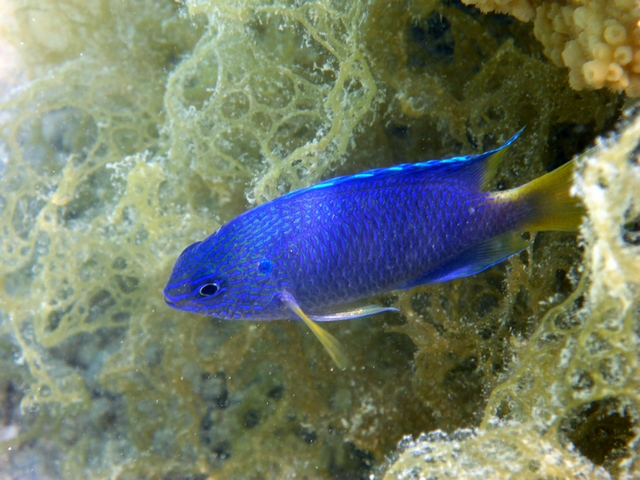
Much smaller but even more eye-catching were the little blue devil damselfish (Chrysiptera cyanea), which like the green pullers were everywhere in the shallows, darting in and out of the cover of seaweed or coral outcrops. These electric blue tiddlers were smaller than my thumb, but what they lack in size they make up for in attitude: they’re fiercely territorial and often darted out to chase me away if I got too close to their home turf.
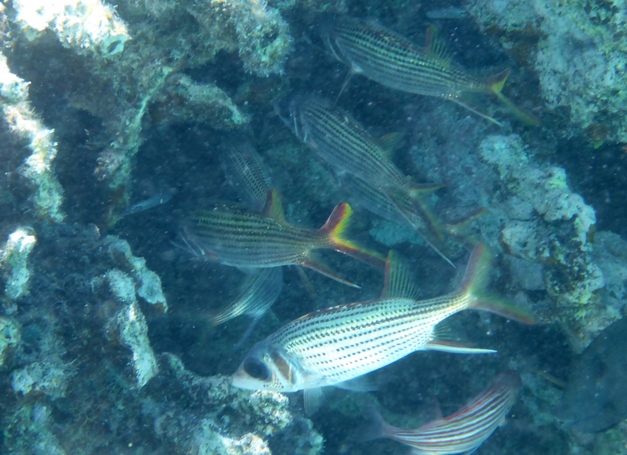
The reef is obviously a challenging place to live, with plenty of predators (not to mention human hunters). Fight, flight or hide are the strategies its inhabitants can select, but luckily I didn’t encounter anything which chose the first option. Most fish kept a watchful eye on me and when I came too close for comfort either zipped away into the blue or disappeared into nooks and crannies in the coral (like these clearfin and bloodspot squirrelfish, Neoniphon argenteus and N. sammara, or kūkū).
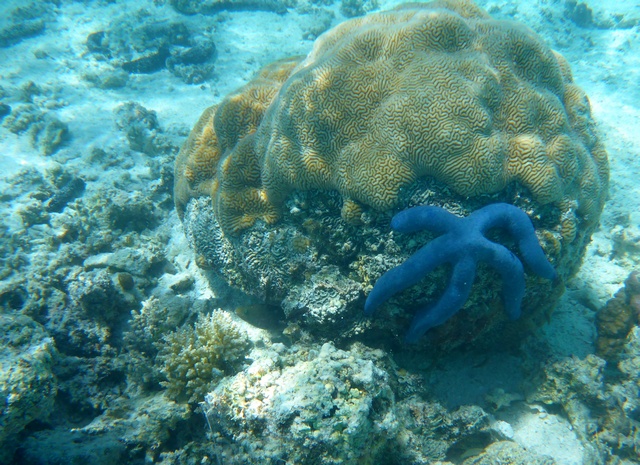
Of course, fight, flight or hide isn’t an option for all the reef’s creatures. Hard corals such as this lesser brain coral (Leptoria phrygia) are free-swimming in their larval stage, but once they settle on the seabed and develop into a polyp and eventually a colony, their destiny is fixed: at the mercy of sea currents, waves and storms, pollution, temperatures and pH. The calcium carbonate walls which each coral polyp fortifies itself within – and which form the beautiful and fragile sculptures that make up coral reefs – will dissolve if the pH of the ocean around them falls too low and grows acid.
A study published in Science magazine in 2018 predicts that ocean acidification (largely caused by increased amounts of carbon dioxide dissolving into our oceans, as a result of climate change) will reach a point by 2080 when coral reefs are dissolving faster than they can rebuild themselves. This is on top of warmer ocean temperatures causing coral bleaching, when corals expel the algae living symbiotically in their tissues. Bleached corals lose their brilliant colours and are functionally ‘sick’: not only does a bleached reef look a sad sight, but the coral will probably be unable to reproduce and will eventually die if sea temperatures do not reduce back to tolerable levels.
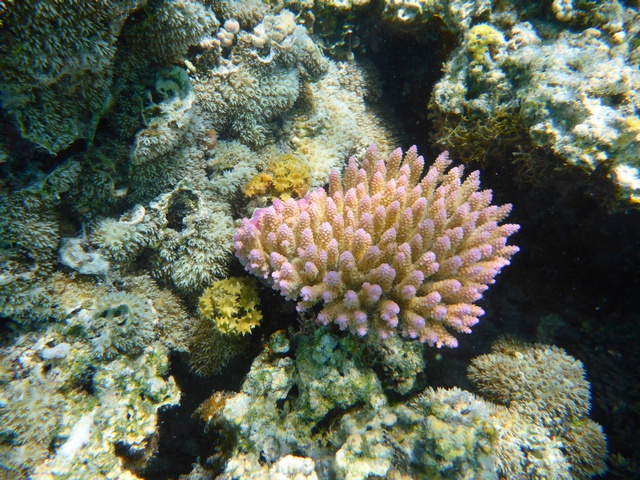
Wildlife like this pink Acropora digitifera coral and plants such as spiny-leaf seaweed (Turbinaria ornata or rimu taratara) not only create gorgeous places to snorkel round and explore, they are vital wildlife ecosystems in our planetary environment. They provide ecosystem services to humans too: sources of food for local people, and protective physical barriers around low-lying islands against cyclones and flooding. Some of the scuba divers whom I met while staying on Aitutaki spoke of how the coral reef around the island looked to them to be suffering from bleaching, as well as from physical damage caused by tourists and boat anchors. It made me feel doubly privileged – and careful of my impact – while snorkeling around these underwater treasure-troves.
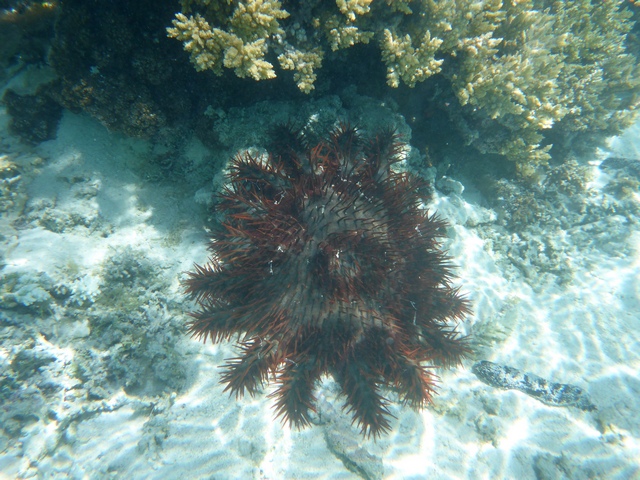
The vivid blue starfish (Linckia laevigata or ‘etū-tai) creeping slowly over the brain coral was doing it no harm; its larger cousin the crown-of-thorns starfish (Acanthaster planci or taramea) is a different matter. I found these spiky behemoths several times when I was out snorkelling: they feed on the coral polyps, digesting their living tissues and leaving the white calcium skeleton structure behind. A single crown-of-thorns can consume up to six square metres (sixty-five square feet) of living coral in a year.
They are native predators and as such can actually promote structural and species diversity in coral reefs; but if they’re present in great numbers (a so-called ‘crown-of-thorns plague’) they can cause widespread destruction to a coral reef habitat. For that reason, many divers and fishermen dislike them and will kill them on sight. One recommended method I was told about is to chop the starfish up with a big knife or machete. As these beasties are well-armed with poisonous spines which will break off in your flesh, I didn’t feel remotely tempted to try it. The asterosaponin toxins which the spines contain cause stinging, swelling, bleeding and nausea: definitely a marine creature to be given a respectful distance.
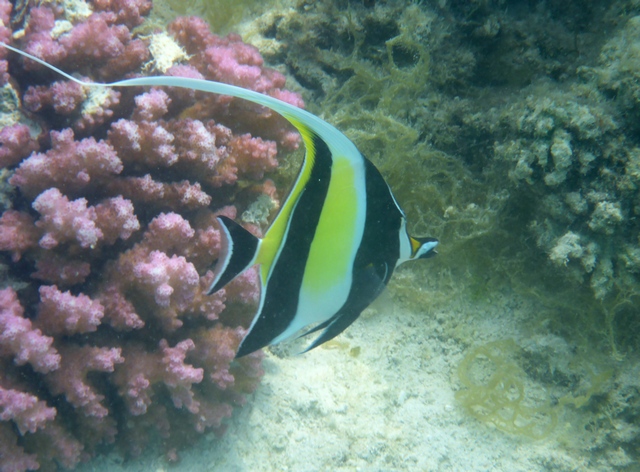
One fish which I was ridiculously excited to find (and when I get ridiculously excited when snorkeling I make noises like a baby whale with ADHD) was the fabulous Moorish idol (Zanclus cornutus or rere’au). This beauty was gliding around the coral like a piece of fine ceramic art, but put on an impressive turn of speed when I tried to get closer for a photo. I’m not someone who gets excited by celebrities, but remembering this fish as Gill in Finding Nemo, I stalked it for ten minutes until it finally got tired of my adoration and huffed off with a flick of its elegant long dorsal fin.
I could probably have spent most of my stay on Aitutaki in the sea, captivated by the ever-changing artistry of the marine world. As mentioned earlier in this blog, when I was a kid I was enamoured by the TV cartoon Marine Boy, the first ever Japanese colour anime to be shown on UK television. Basically I wanted to be Marine Boy: I coveted his red wetsuit, his oxy-gum (which when chewed enabled him to breathe underwater), his dolphin sidekick and his mermaid friend (whose modesty was always miraculously concealed by strategically-draped hair). My obsession with this cartoon knew no bounds: I was once hauled out of the bottom of a swimming pool by a lifeguard, whilst sitting underwater attempting to breathe as if I had oxy-gum.
I never magically gained the ability to breathe like a fish, but the clunky yet charming animated undersea world of Marine Boy permeated my psyche and remains there to this day. When I’m swimming in the sea (or traveling across it on a boat) I am probably the happiest I ever get.
I stayed snorkeling in the lagoon till evening sank the sun into the sea. When I walked out onto the still-warm sand of Matriki’s beach, the ocean had become a great calm mirror, holding onto the sky’s fading light. For another day’s stay on this beautiful South Pacific island, I gave thanks. Meitaki atupaka.
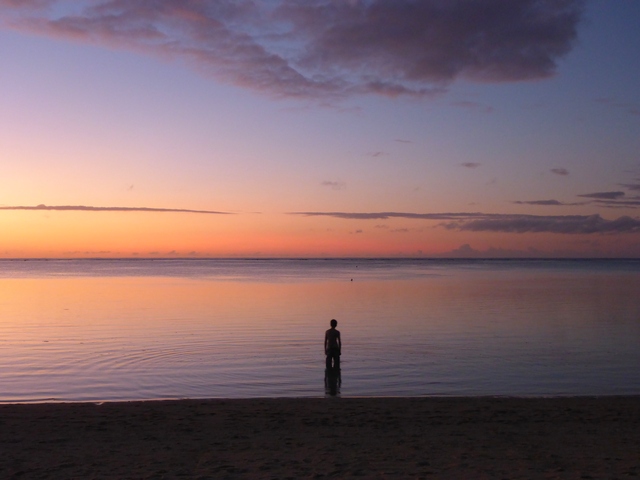
Coming up next time, in South Pacific Adventure part 6:
Camera disaster; swimming with humpback whales; learning about Aitutaki’s history; and how we survived a tsunami warning.
…And if you’d like to read about my South Pacific travels from the beginning, go to the first chapter: Travels in the Cook Islands.
